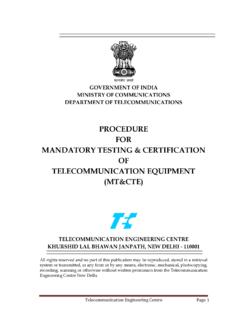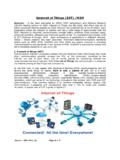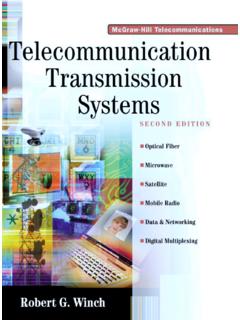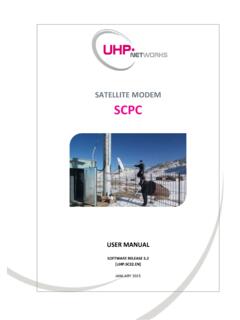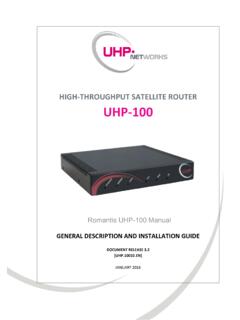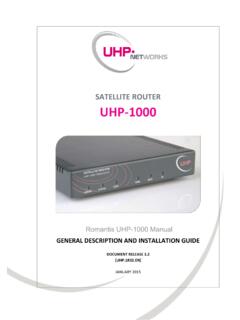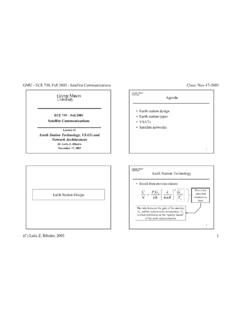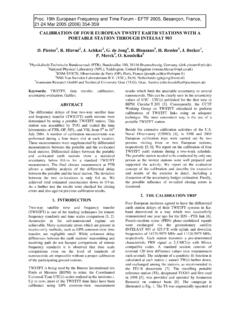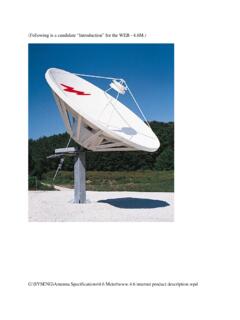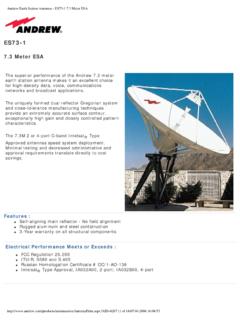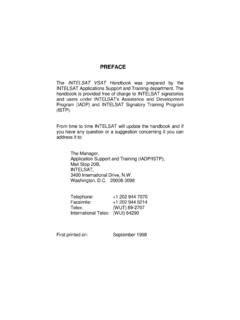Transcription of Satellite Interference and Carrier ID
1 1 Satellite Interference and Carrier ID (Radio Division) 1 Introduction Satellite operators all across the globe have been suffering heavily in terms of revenue losses because of Radio Frequency Interference (RFI). Radio Frequency Interference (RFI) highly impacts the Quality of Service for Satellite operators and their customers. With Satellite transmissions it is difficult to identify the source of this Interference . This in particular applies to occasional-use Satellite transmissions and temporary feeder links, rather than to full time DTH (Direct To Home) services, where the owners and locations of the uplinks are well known and identified.
2 Realizing the acuteness and criticality of this problem, telecommunication standardization bodies like ITU, World Broadcasting Union, ETSI to name a few as well as the consortium of Satellite operators like DVB etc. decided to come up with effective standards addressing Satellite Interference globally. Keeping in mind that the number of fixed- Satellite service (FSS) earth stations used for occasional use (OU) Carrier transmissions in the 4/6 GHz and 11-12/13/14 GHz FSS bands is increasing rapidly.
3 That the OU transmissions are often characterized by frequent changes in earth station antenna pointing, frequency, power level, polarization sense, Carrier bandwidth and modulation technique and also that the proliferation of the use of OU transmitting earth stations, and their frequent changes in link parameters, has caused an increase in unintentional Interference to other Satellite users, the various standardization bodies came up with the Carrier ID solution to be leveraged effectively to combat RFI problem.
4 In this study paper, the Satellite Interference scenarios are discussed briefly and how the recommended Carrier ID solution can be employed to effectively curb it. 2 Satellite Interference and its Types The statistics in the Figure 1 below depict the major types or reasons for Satellite Interference or RFI. Figure Satellite Interference statistics provided by intelsat Report 2013. 2 Some of the major Interference types are discussed below: Adjacent Satellite Interference This is generally caused due to installation errors by operator, or poor inter-system coordination.
5 Transmitting antenna from the uplink site is poorly pointed and hence directs its signals to the unintended Satellite . This is becoming more prevalent as two degree spacing between satellites in the geostationary arc becomes more common. Cross polar Interference This arises in cases where two different terminals are uplinking signals in the opposite sense of the same kind of polarization, for example vertical polarization (VP) adjacent to horizontal polarization (HP), or right-hand circular (RHC) adjacent to left-hand circular (LHC) polarization.
6 The extent of cross polar Interference then depends on the ground station antenna cross polar gain and the cross polar discrimination margin implemented in the system. Co-ordination of network parameters specifications between the ground stations of the different Satellite networks also plays a major role in defining the extent of this type of Interference . Interference due to equipment faults This includes Interference internal to the Satellite network (equipment and cabling faults, poor quality transmission equipment, human error settings of polarisation and frequency etc.)
7 No regulations as such are in place to handle these problems and are internally handled by the Satellite operators at their ends by installing high quality equipments and carrying out proper training of their personnel and capacity development. Interference due to Unauthorized carriers and Deliberate Jamming Interference due to unauthorized carriers results from carriers (with content) being transmitted towards a Satellite without any prior contract/authorisation put in place with the Satellite operator ( piracy).
8 Intentional or deliberate jamming of Satellite signals is generally achieved by carriers (often unmodulated) transmitted towards a Satellite with the intent to prevent the current signals to be transmitted. This is often geopolitically motivated and though easy to locate yet difficult to mitigate as it requires political clearances etc. 3 Satellite Interference mitigating techniques: Carrier ID ITU is currently working on the specification for Carrier Identifier ( Carrier ID) which contains information related to the source such as operator s name, phone number etc.
9 , to identify a source of a Carrier to be transmitted with the uplink signals to mitigate Satellite Interference . This technique has been suggested by the Satellite Interference Reduction Group (sIRG). The Satellite Interference Reduction Group (sIRG) members include Satellite operators, service providers, broadcasters, and equipment manufacturers. Three working groups were formed within the sIRG to address different segments of the Satellite industry.
10 The Broadcast, VSAT, and Data groups are pursuing approaches to mitigate Interference that are unique to their segments of the market. Though there are several ways by which Carrier ID can be transmitted along with the original Carrier , considering minimal adverse effects, following two methods are being considered mainly by the ITU Working Group for the specification: 3 Insert the Carrier -ID, a small string, into the network information table frame on the original Carrier In this method, for instance, Carrier ID consisting of the manufacturer s name, the unique unit serial number etc.
